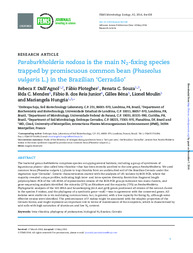Paraburkholderia nodosa is the main N2-fixing species trapped by promiscuous common bean (Phaseolus vulgaris L.) in the Brazilian 'Cerradão'.
Paraburkholderia nodosa is the main N2-fixing species trapped by promiscuous common bean (Phaseolus vulgaris L.) in the Brazilian 'Cerradão'.
Author(s): DALL'AGNOL, R. F.; PLOTEGHER, F.; SOUZA, R. C.; MENDES, I. de C.; REIS JUNIOR, F. B. dos; BÉNA, G.; MOULIN, L.; HUNGRIA, M.
Summary: The bacterial genus Burkholderia comprises species occupying several habitats, including a group of symbionts of leguminous plants?also called beta-rhizobia?that has been recently ascribed to the new genus Paraburkholderia. Weused common bean ( Phaseolus vulgaris L.) plants to trap rhizobia from an undisturbed soil of the Brazilian Cerrado under the vegetation type ?Cerradão?. Genetic characterization started with the analyses of 181 isolates by BOX-PCR, where the majority revealed unique profiles, indicating high inter- and intra-species diversity. Restriction fragment length polymorphism-PCR of the 16S rRNA of representative strains of the BOX-PCR groups indicated two main clusters, and gene-sequencing analysis identified the minority (27%) as Rhizobium and the majority (73%) as Paraburkholderia. Phylogenetic analyses of the 16S rRNA and housekeeping (recA and gyrB) genes positioned all strains of the second cluster in the species P. nodosa , and the phylogeny of a symbiotic gene?nodC ?was in agreement with the conserved genes. All isolates were stable vis-à-vis nodulating common bean, but, in general, with a low capacity for fixing N2 , although some effective strains were identified. The predominance of P. nodosa might be associated with the edaphic properties of the Cerrado biome, and might represent an important role in terms of maintenance of the ecosystem, which is characterized by acid soils with high saturation of aluminum and low N2 content.
Publication year: 2016
Types of publication: Journal article
Unit: Embrapa Soybean
Keywords: Bactéria, Cerrado, Fixação biológica, Fixação biológica de nitrogênio
Observation
Some of Embrapa's publications are published as ePub files. To read them, use or download one of the following free software options to your computer or mobile device. Android: Google Play Books; IOS: iBooks; Windows and Linux: Calibre.
Access other publications
Access the Agricultural Research Database (BDPA) to consult Embrapa's full library collection and records.
Visit Embrapa Bookstore to purchase books and other publications sold by Embrapa.

